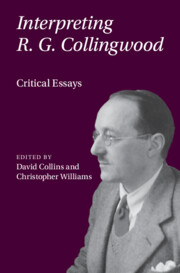Book contents
- Interpreting R. G. Collingwood
- Interpreting R. G. Collingwood
- Copyright page
- Contents
- Figures
- Contributors
- Acknowledgements
- Abbreviations
- Introduction
- Part I Situating Collingwood: Beyond Idealism
- Part II Issues in Collingwood’s Philosophy
- Chapter 7 Collingwood’s Logic of Question and Answer
- Chapter 8 Presuppositional Analysis and the Goal of Metaphysical Inquiry
- Chapter 9 Is Collingwood a Process Philosopher?
- Chapter 10 Collingwood on Imagination
- Chapter 11 Collingwood on “Painting Imaginatively” and the Expressive Nature of the Artwork
- Chapter 12 Collingwood’s Influence on Baxandall
- Chapter 13 “Reconsidering Questions of Principle”: Collingwood and the Revival of Celtic Art
- Chapter 14 What Is Living and What Is Dead in Collingwood’s New Leviathan?
- Bibliography
- Index
Chapter 12 - Collingwood’s Influence on Baxandall
Abductive Reasoning and the Triangle of Re-enactment
from Part II - Issues in Collingwood’s Philosophy
Published online by Cambridge University Press: 22 November 2024
- Interpreting R. G. Collingwood
- Interpreting R. G. Collingwood
- Copyright page
- Contents
- Figures
- Contributors
- Acknowledgements
- Abbreviations
- Introduction
- Part I Situating Collingwood: Beyond Idealism
- Part II Issues in Collingwood’s Philosophy
- Chapter 7 Collingwood’s Logic of Question and Answer
- Chapter 8 Presuppositional Analysis and the Goal of Metaphysical Inquiry
- Chapter 9 Is Collingwood a Process Philosopher?
- Chapter 10 Collingwood on Imagination
- Chapter 11 Collingwood on “Painting Imaginatively” and the Expressive Nature of the Artwork
- Chapter 12 Collingwood’s Influence on Baxandall
- Chapter 13 “Reconsidering Questions of Principle”: Collingwood and the Revival of Celtic Art
- Chapter 14 What Is Living and What Is Dead in Collingwood’s New Leviathan?
- Bibliography
- Index
Summary
This chapter is concerned with method in art history and focuses on R. G. Collingwood’s impact on Michael Baxandall’s contribution to this subject in Patterns of Intention (1985). It begins with a discussion of Baxandall’s appeal to Collingwood’s notion of “re-enactment” and Karl Popper’s “situational logic,” followed by an explanation of the Collingwoodian roots of his “triangle of re-enactment.” Taking for granted that the proper interpretation of Collingwood’s notion of “re-enactment” is in terms of Peirce’s notion of “abduction,” itself understood in terms of the “Gabbay–Woods schema,” I then offer a reading of chapter IV and Baxandall’s analysis of Piero della Francesca’s Baptism of Christ, that bring to the fore the central influence of Collingwood’s conceptions – the claim being that Baxandall’s successful application of them shows their worth.
Keywords
- Type
- Chapter
- Information
- Interpreting R. G. CollingwoodCritical Essays, pp. 223 - 245Publisher: Cambridge University PressPrint publication year: 2024

